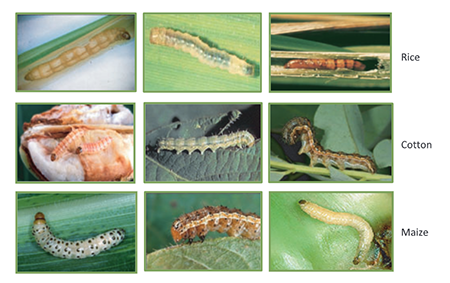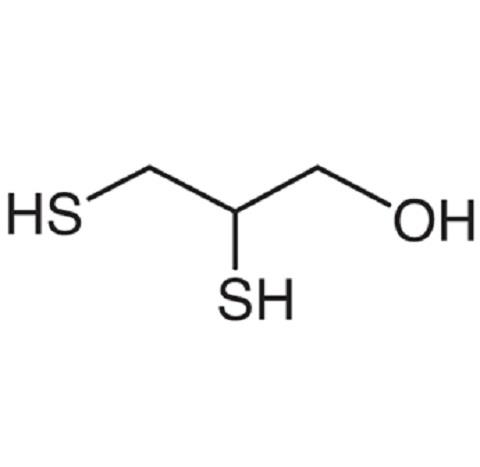Uses of Bacillus thuringiensis
Bacillus thuringiensis is a group of strains or isolates of naturally occurring soil bacteria of the Bacillus cereus group that are used to control insect pests on agricultural crops, stored food crops, ornamental plants, forests, and nuisance or disease-vector insect in natural water bodies and around homes. Bacillus thuringiensis can be readily distinguished from other members of the B. cereus group by the production of large crystalline inclusions that consist of entomocidal proteins, the Crystal (Cry) and Cytolytic (Cyt) toxins, also called d-endotoxins. Cry and Cyt toxins result from the transformation of relatively inert crystalline protoxins into cytotoxic forms at the alkaline pH conditions of insect midgut. Different strains of Bacillus thuringiensis have specific toxicity to particular types of insects depending on the type and number of protoxins in the crystalline inclusions that they produce. Cry toxins are highly diverse and primarily target insects in the orders Lepidoptera (butterflies and moths), Diptera (flies and mosquitoes), and Coleoptera (beetles and weevils); however, some Cry toxins have been reported to kill hymenopterans (wasps and bees) and nematodes. In contrast, Cyt toxins are mostly found in Bacillus thuringiensis strains active against Diptera. Most Bacillus thuringiensis-based insecticides are formulated mixtures of d-endotoxin crystals and Bacillus thuringiensis spores. The Bacillus thuringiensis spores synergize the toxicity of the crystalline proteins.

Uses
Bacillus thuringiensis is considered an almost ideal agent for pest management because of its combination of insecticidal selectivity and lack of toxicity to humans, mammals, birds, fish, plants, and most aquatic organisms.
Bacillus thuringiensis has been used in spray formulations for more than 40 years, and more recently its insecticidal protein genes have been incorporated into several major crops. Due to their insecticidal activity, Cry toxins are used worldwide as bioinsecticides to control disease-vector insect and crop pest populations.
One of the most successful applications of Bacillus thuringiensis has been the control of lepidopteran defoliators, which are pests of coniferous forests mainly in Canada and the United States. Bacillus thuringiensis subsp. israelensis (Bacillus thuringiensisi) is highly active against larvae of disease-vector mosquitoes like Aedes aegypti (vector of dengue fever), Aedes albopictus (vector of chikungunya), Simulium damnosum (vector of onchocerciasis), and certain Anopheles species (vectors of malaria). Bacillus thuringiensisi formulations (WG, water-dispersible granule; DT, ready-to-use tablet) have been evaluated by the World Health Organization Pesticide Evaluation Scheme (WHOPES) and recommended as mosquito larvicides, including their use against mosquito larvae that develop in drinking-water containers. Successful application of Bacillus thuringiensis is highly dependent on proper timing, weather conditions, and dosage of spray applications. These factors combine to determine the probability of larvae ingesting a lethal dose.
Recently, the use of Cry toxins has increased dramatically following the introduction of cry genes into plants. These ‘Bacillus thuringiensis crops’ have thus far proved to be an effective control strategy, and in 2004 Bacillus thuringiensis-maize and Bacillus thuringiensis-cotton were grown on 22.4 million hectares worldwide. Such widespread use, however, has led to concerns about the effect Bacillus thuringiensis crops may have on the environment and on human health.
Environmental Fate
Bacillus thuringiensis is moderately persistent in soil with a half-life of ca. 4 months.Bacillus thuringiensis subsp. israelensis is often applied directly to water for the control of mosquitoes and blackflies. It has been demonstrated that the sedimentation of Bacillus thuringiensisi is facilitated by adsorption onto particulate material. Bacillus thuringiensisi can persist as long as 5 months in cold water, and adsorption to particulate matter in water facilitates persistence.
Bacillus thuringiensis is relatively short-lived on foliage due to rapid photodegradation. Its half-life under normal sunlight conditions is 3.8 h. In general, Bacillus thuringiensis loses 50% of its insecticide activity in 1-3 days after spraying. However, high toxicity toward mosquito larvae has been found in decaying leaf litter collected in several natural mosquito breeding sites in forested areas. From the toxic fraction of the leaf litter, B. cereus-like bacteria were isolated and further characterized as Bacillus thuringiensis subsp. israelensis using PCR (polymerase chain reaction) amplification of specific toxin genes. The anthropogenic origin of Bacillus thuringiensisi was demonstrated by amplified fragment length polymorphism (AFLP) profile comparisons. Nevertheless, persistence of acute toxicity several months after Bacillus thuringiensisi spraying remains exceptional, as this was only observed once in only one out of eight sampling sites. In this particular site, Bacillus thuringiensisi spores and toxins may be protected from degradation by the vegetal matrix.//Bacillus thuringiensis Cry and Cyt toxins belong to a class of bacterial toxins known as pore-forming toxins (PFT) that are secreted as watersoluble proteins undergoing conformational changes in order to insert into, or to translocate across, cell membranes of their host. The primary action of Cry toxins is to lyse midgut epithelial cells in the target insect by forming pores in the apical microvilli membrane of the cells.
Mechanism
Bacillus thuringiensis is ineffective against adult insects and must be eaten by feeding larvae in order to be toxic. When ingested by insect larvae, sporulated-Bacillus thuringiensis crystalline inclusions dissolve in the alkaline environment of insect gut, and the solubilized inactive protoxins are converted into protease resistant active Cry and Cyt toxins. Toxin activation involves N-terminal, Cterminal, and intra-molecular cleavage. The activated Cry toxins are composed of three functional domains, a seven ahelices bundle that is involved in membrane insertion (domain I), and two b-sheet domains (domains II and III) involved in receptor interactions. Once activated, Cry toxins bind to specific receptors on the brush border membrane of the midgut epithelium columnar cells before inserting into the membrane. Toxin insertion leads to the formation of lytic pores in microvilli of apical membranes. Subsequently cell lysis and disruption of the midgut epithelium release the cell content providing the spores with a germinating medium leading to a severe septicemia and insect death.
You may like
Related articles And Qustion
See also
Lastest Price from Bacillus thuringiensis manufacturers

US $3.20/box2025-09-28
- CAS:
- 68038-71-1
- Min. Order:
- 1box
- Purity:
- 99%
- Supply Ability:
- 20tons per month

US $10.00/KG2025-04-21
- CAS:
- 68038-71-1
- Min. Order:
- 1KG
- Purity:
- 99%
- Supply Ability:
- 10 mt


